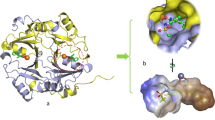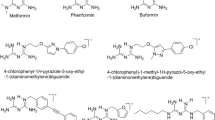Abstract
The glyoxalase-I (GLO-I) enzyme, which is the initial enzyme of the glyoxalase system that is responsible for the detoxification of cytotoxic α-ketoaldehydes, such as methylglyoxal, has been approved as a valid target in cancer therapy. Overexpression of GLO-I has been observed in several types of carcinomas, including breast, colorectal, prostate, and bladder cancer. In this work we aimed to identify potential GLO-I inhibitors via employing different structure-based drug design techniques including structure-based poly-pharmacophore modelling, virtual screening, and molecular docking. Poly-pharmacophore modelling was applied in this study in order to thoroughly explore the binding site of the target enzyme, thereby, revealing hits that could bind in a nonconventional way which can pave the way for designing more potent and selective ligands with novel chemotypes. The modelling phase has resulted in the selection of 31 compounds that were biologically evaluated against human GLO-I enzyme. Among the tested set, seven compounds showed excellent inhibitory activities with IC50 values ranging from 0.34 to 30.57 μM. The most active compound (ST018515) showed an IC50 of 0.34 ± 0.03 μM, which, compared to reported GLO-I inhibitors, can be considered a potent inhibitor, making it a good candidate for further optimization towards designing more potent GLO-I inhibitors.








Similar content being viewed by others
References
Dakin HD, Dudley HW (1913) An enzyme concerned with the formation of hydroxy acids from ketonic aldehydes. J Biol Chem 14(2):155–157
Thornalley PJ (1996) Pharmacology of methylglyoxal: formation, modification of proteins and nucleic acids, and enzymatic detoxification-A role in pathogenesis and antiproliferative chemotherapy. Gen Pharmacol: Vasc Syst 27(4):565–573. https://doi.org/10.1016/0306-3623(95)02054-3
Warburg O, Wind F, Negelein E (1927) The metabolism of tumors in the body. J Gen Physiol 8(6):519–530
Chen Y-L, Li Q-Z (2007) Prediction of apoptosis protein subcellular location using improved hybrid approach and pseudo-amino acid composition. J Theor Biol 248(2):377–381. https://doi.org/10.1016/j.jtbi.2007.05.019
Sousa Silva M, Gomes Ricardo A, Ferreira Antonio EN, Ponces Freire A, Cordeiro C (2013) The glyoxalase pathway: the first hundred years… and beyond. Biochem J 453(1):1–15. https://doi.org/10.1042/bj20121743
Guo Y, Zhang Y, Yang X, Lu P, Yan X, Xiao F, Zhou H, Wen C, Shi M, Lu J, Meng QH (2016) Effects of methylglyoxal and glyoxalase I inhibition on breast cancer cells proliferation, invasion, and apoptosis through modulation of MAPKs, MMP9, and Bcl-2. Cancer Biol Ther 17(2):169–180. https://doi.org/10.1080/15384047.2015.1121346
Thornalley PJ (2003) Protecting the genome: defence against nucleotide glycation and emerging role of glyoxalase I overexpression in multidrug resistance in cancer chemotherapy. Biochem Soc Trans 31(6):1372. https://doi.org/10.1042/bst0311372
Rulli A, Carli L, Romani R, Baroni T, Giovannini E, Rosi G, Talesa V (2001) Expression of glyoxalase I and II in normal and breast cancer tissues. Breast Cancer Res Treat 66(1):67–72. https://doi.org/10.1023/A:1010632919129
Mearini E, Romani R, Mearini L, Antognelli C, Zucchi A, Baroni T, Porena M, Talesa V (2002) Differing expression of enzymes of the glyoxalase system in superficial and invasive bladder carcinomas. Eur J Cancer 38(14):1946–1950. https://doi.org/10.1016/S0959-8049(02)00236-8
Sakamoto H, Mashima T, Sato S, Hashimoto Y, Yamori T, Tsuruo T (2001) Selective activation of apoptosis program by Sp-bromobenzylglutathione cyclopentyl diester in glyoxalase I-overexpressing human lung cancer cells. Clin Cancer Res 7(8):2513–2518
Sakamoto H, Mashima T, Kizaki A, Dan S, Hashimoto Y, Naito M, Tsuruo T (2000) Glyoxalase I is involved in resistance of human leukemia cells to antitumor agent-induced apoptosis. Blood 95(10):3214–3218
Thornalley PJ, Rabbani N (2011) Glyoxalase in tumourigenesis and multidrug resistance. Semin Cell Dev Biol 22(3):318–325. https://doi.org/10.1016/j.semcdb.2011.02.006
Kreycy N, Gotzian C, Fleming T, Flechtenmacher C, Grabe N, Plinkert P, Hess J, Zaoui K (2017) Glyoxalase 1 expression is associated with an unfavorable prognosis of oropharyngeal squamous cell carcinoma. BMC Cancer 17(1):382. https://doi.org/10.1186/s12885-017-3367-5
Hai-Tao Peng JC, Liu Tian-Yu, Yan-Qing Wu, Lin Xiao-Hong, Lai Yuan-Hui, Huang Ying-Feng (2017) Up-regulation of the tumor promoter glyoxalase-1 indicates poor prognosis in breast cancer. Int J Clin Exp Pathol 10(11):10852–10862
Vince R, Wadd WB (1969) Glyoxalase inhibitors as potential anticancer agents. Biochem Biophys Res Commun 35(5):593–598. https://doi.org/10.1016/0006-291X(69)90445-8
Murthy NSRK, Bakeris T, Kavarana MJ, Hamilton DS, Lan Y, Creighton DJ (1994) S-(N-Aryl-N-hydroxycarbamoyl)glutathione derivatives are tight-binding inhibitors of glyoxalase I and slow substrates for glyoxalase II. J Med Chem 37(14):2161–2166. https://doi.org/10.1021/jm00040a007
More SS, Vince R (2009) Inhibition of glyoxalase I: the first low-nanomolar tight-binding inhibitors. J Med Chem 52(15):4650–4656. https://doi.org/10.1021/jm900382u
Vince R, Daluge S, Wadd WB (1971) Inhibition of glyoxalase I by S-substituted glutathiones. J Med Chem 14(5):402–404. https://doi.org/10.1021/jm00287a006
Takasawa R, Takahashi S, Saeki K, Sunaga S, Yoshimori A, Tanuma S-i (2008) Structure-activity relationship of human GLO I inhibitory natural flavonoids and their growth inhibitory effects. Bioorg Med Chem 16(7):3969–3975. https://doi.org/10.1016/j.bmc.2008.01.031
Liu M, Yuan M, Luo M, Bu X, Luo H-B, Hu X (2010) Binding of curcumin with glyoxalase I: molecular docking, molecular dynamics simulations, and kinetics analysis. Biophys Chem 147(1):28–34. https://doi.org/10.1016/j.bpc.2009.12.007
Chiba T, Ohwada J, Sakamoto H, Kobayashi T, Fukami TA, Irie M, Miura T, Ohara K, Koyano H (2012) Design and evaluation of azaindole-substituted N-hydroxypyridones as glyoxalase I inhibitors. Bioorg Med Chem Lett 22(24):7486–7489. https://doi.org/10.1016/j.bmcl.2012.10.045
Perez C, Barkley-Levenson AM, Dick BL, Glatt PF, Martinez Y, Siegel D, Momper JD, Palmer AA, Cohen SM (2019) Metal-binding pharmacophore library yields the discovery of a glyoxalase 1 inhibitor. J Med Chem 62(3):1609–1625. https://doi.org/10.1021/acs.jmedchem.8b01868
Takasawa R, Tao A, Saeki K, Shionozaki N, Tanaka R, Uchiro H, Takahashi S, Yoshimori A, Tanuma S-i (2011) Discovery of a new type inhibitor of human glyoxalase I by myricetin-based 4-point pharmacophore. Bioorg Med Chem Lett 21(14):4337–4342. https://doi.org/10.1016/j.bmcl.2011.05.046
Al-Balas Q, Hassan M, Al-Oudat B, Alzoubi H, Mhaidat N, Almaaytah A (2012) Generation of the first structure-based pharmacophore model containing a selective “zinc binding group” feature to identify potential glyoxalase-1 inhibitors. Molecules 17(12):13740–13758. https://doi.org/10.3390/molecules171213740
Al-Balas QA, Hassan MA, Al-Shar’i NA, Mhaidat NM, Almaaytah AM, Al-Mahasneh FM, Isawi IH (2016) Novel glyoxalase-i inhibitors possessing a “zinc-binding feature” as potential anticancer agents. Drug design, development and therapy 10:2623. https://doi.org/10.2147/DDDT.S110997
Al-Balas QA, Hassan MA, Al-Shar'i NA, Al Jabal GA, Almaaytah AM (2019) Recent advances in glyoxalase-I inhibition. Mini-Rev Med Chem 19(4):281–291. https://doi.org/10.2174/1389557518666181009141231
Cameron AD, Olin B, Ridderström M, Mannervik B, Jones TA (1997) Crystal structure of human glyoxalase I-evidence for gene duplication and 3D domain swapping. EMBO J 16(12):3386–3395. https://doi.org/10.1093/emboj/16.12.3386
Cameron AD, Ridderström M, Olin B, Kavarana MJ, Creighton DJ, Mannervik B (1999) Reaction mechanism of glyoxalase I explored by an X-ray crystallographic analysis of the human enzyme in complex with a transition state analogue. Biochemistry 38(41):13480–13490. https://doi.org/10.1021/bi990696c
Biovia DS (2017) Discovery studio modeling environment, Pipeline Pilot Client. Dassault Systèmes, San Diego
DeLano WL (2002) The PyMOL molecular graphics system. DeLano Scientific, San Carlos, CA
GraphPad Prism (2012). 6.01 for Windows edn., La Jolla California USA
Berman HM, Battistuz T, Bhat TN, Bluhm WF, Bourne PE, Burkhardt K, Feng Z, Gilliland GL, Iype L, Jain S, Fagan P, Marvin J, Padilla D, Ravichandran V, Schneider B, Thanki N, Weissig H, Westbrook JD, Zardecki C (2002) The protein data bank. Acta Crystallogr D 58(1):899–907. https://doi.org/10.1107/S0907444902003451
Berman H (2008) The protein data bank: a historical perspective. Acta Crystallogr A 64(1):88–95. https://doi.org/10.1107/S0108767307035623
Spassov VZ, Flook PK, Yan L (2008) LOOPER: a molecular mechanics-based algorithm for protein loop prediction. Protein Eng Des Sel 21(2):91–100. https://doi.org/10.1093/protein/gzm083
Spassov VZ, Yan L (2008) A fast and accurate computational approach to protein ionization. Protein Sci 17(11):1955–1970. https://doi.org/10.1110/ps.036335.108
Al-Shar’i NA, Hassan M, Al-Balas Q (2015) Identification of possible glyoxalase II inhibitors as anticancer agents by a customized 3D structure-based pharmacophore mode. Jordan J Pharm Sci 8(5):83–103
Wu G, Robertson DH, Brooks CL, Vieth M (2003) Detailed analysis of grid-based molecular docking: a case study of CDOCKER-A CHARMm-based MD docking algorithm. J Comput Chem 24(13):1549–1562. https://doi.org/10.1002/jcc.10306
Schlick T (2002) Geometry optimization. In: von Ragué Schleyer P, Allinger NL, Clark T et al (eds) Encyclopedia of computational chemistry. Wiley, New York
Tirado-Rives J, Jorgensen WL (2006) Contribution of conformer focusing to the uncertainty in predicting free energies for protein−ligand binding. J Med Chem 49(20):5880–5884. https://doi.org/10.1021/jm060763i
Genheden S, Ryde U (2015) The MM/PBSA and MM/GBSA methods to estimate ligand-binding affinities. Expert Opin Drug Discov 10(5):449–461. https://doi.org/10.1517/17460441.2015.1032936
Al-Balas QA, Hassan MA, Al Jabal GA, Al-Shar’i NA, Almaaytah AM, El-Elimat T (2017) Novel thiazole carboxylic acid derivatives possessing a “zinc binding feature” as potential human glyoxalase-I inhibitors. Lett Drug Des Discov 14(11):1324–1334. https://doi.org/10.2174/1570180814666170306120954
Fonseca-Sanchez MA, Rodriguez Cuevas S, Mendoza-Hernandez G, Bautista-Pina V, Arechaga Ocampo E, Hidalgo Miranda A, Quintanar Jurado V, Marchat LA, Alvarez-Sanchez E, Perez Plasencia C, Lopez-Camarillo C (2012) Breast cancer proteomics reveals a positive correlation between glyoxalase 1 expression and high tumor grade. Int J Oncol 41(2):670–680. https://doi.org/10.3892/ijo.2012.1478
Hutschenreuther A, Bigl M, Hemdan NY, Debebe T, Gaunitz F, Birkenmeier G (2016) Modulation of GLO1 expression affects malignant properties of cells. Int J Mol Sci 17(12):2133. https://doi.org/10.3390/ijms17122133
Botta CB, Cabri W, Cini E, De Cesare L, Fattorusso C, Giannini G, Persico M, Petrella A, Rondinelli F, Rodriquez M, Russo A, Taddei M (2011) Oxime amides as a novel zinc binding group in histone deacetylase inhibitors: synthesis, biological activity, and computational evaluation. J Med Chem 54(7):2165–2182. https://doi.org/10.1021/jm101373a
Agrawal A, Romero-Perez D, Jacobsen JA, Villarreal FJ, Cohen SM (2008) Zinc-binding groups modulate selective inhibition of MMPs. ChemMedChem 3(5):812–820. https://doi.org/10.1002/cmdc.200700290
Bohm H (1992) The computer program LUDI: a new method for the de novo design of enzyme inhibitors. J Comput Aided Mol Des 6(1):61–78
Böhm H-J (1992) LUDI: rule-based automatic design of new substituents for enzyme inhibitor leads. J Comput Aided Mol Des 6(6):593–606. https://doi.org/10.1007/bf00126217
Lengauer T, Rarey M (1996) Computational methods for biomolecular docking. Curr Opin Struct Biol 6(3):402–406. https://doi.org/10.1016/S0959-440X(96)80061-3
Li H, Leung K-S, Wong M-H, Ballester PJ (2016) Correcting the impact of docking pose generation error on binding affinity prediction. BMC Bioinform 17(Suppl 11):308–308. https://doi.org/10.1186/s12859-016-1169-4
Huang S-Y, Zou X (2007) Efficient molecular docking of NMR structures: application to HIV-1 protease. Protein Sci 16(1):43–51. https://doi.org/10.1110/ps.062501507
Musoev A, Numonov S, You Z, Gao H (2019) Discovery of novel DPP-IV inhibitors as potential candidates for the treatment of type 2 diabetes mellitus predicted by 3D QSAR pharmacophore models, molecular docking and de novo evolution. Molecules 24(16):2870
Zhu T, Cao S, Su P-C, Patel R, Shah D, Chokshi HB, Szukala R, Johnson ME, Hevener KE (2013) Hit identification and optimization in virtual screening: practical recommendations based on a critical literature analysis. J Med Chem 56(17):6560–6572. https://doi.org/10.1021/jm301916b
Loving K, Alberts I, Sherman W (2010) Computational approaches for fragment-based and de novo design. Curr Top Med Chem 10(1):14–32. https://doi.org/10.2174/156802610790232305
Rees DC, Congreve M, Murray CW, Carr R (2004) Fragment-based lead discovery. Nat Rev Drug Discov 3(8):660. https://doi.org/10.1038/nrd1467
Acknowledgements
This work was funded by the Deanship of Scientific Research at Jordan University of Science and Technology, Grant Number (20170288).
Author information
Authors and Affiliations
Corresponding author
Ethics declarations
Conflict of interest
The authors declare that they have no conflict of interest.
Additional information
Publisher's Note
Springer Nature remains neutral with regard to jurisdictional claims in published maps and institutional affiliations.
Electronic supplementary material
Below is the link to the electronic supplementary material.
Rights and permissions
About this article
Cite this article
Al-Shar’i, N.A., Al-Balas, Q.A., Al-Waqfi, R.A. et al. Discovery of a nanomolar inhibitor of the human glyoxalase-I enzyme using structure-based poly-pharmacophore modelling and molecular docking. J Comput Aided Mol Des 33, 799–815 (2019). https://doi.org/10.1007/s10822-019-00226-8
Received:
Accepted:
Published:
Issue Date:
DOI: https://doi.org/10.1007/s10822-019-00226-8




